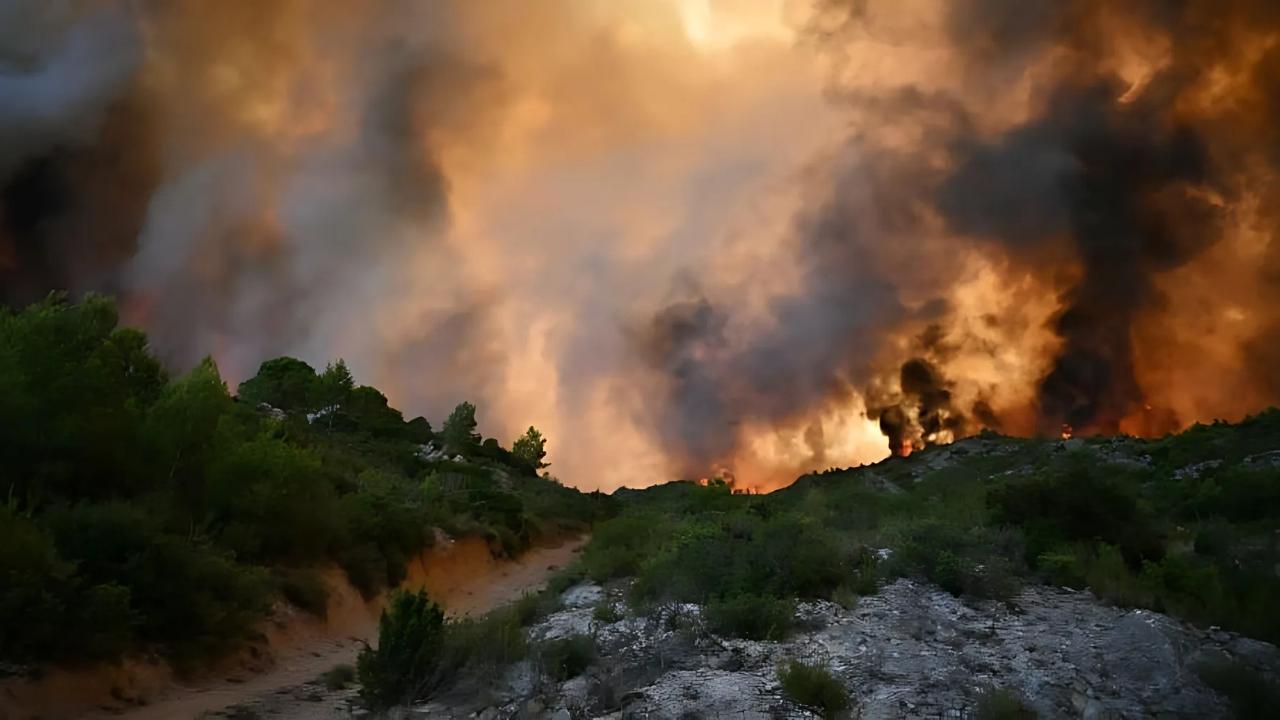
Post by : Priya
Photo:AFP
Southern France experienced one of the largest and most destructive wildfires of the summer season, ravaging the picturesque Aude department near the Spanish border. The fast-moving blaze consumed approximately 11,000 to 13,000 hectares (27,000 to 32,000 acres) of land—an area roughly the size of the city of Paris—and impacted 15 communes, leaving a grim toll of human casualties, property damage, and environmental loss. This editorial aims to offer a detailed, accessible, and comprehensive analysis of the wildfire event, situating it within the broader context of increasing wildfire risks linked to climate change, and emphasizing the challenges of emergency response and community impact.
The Incident: Scale, Damage, and Human Tragedy
The wildfire ignited around 4:15 p.m. in the commune of Ribaute, in the Corbières mountain range, quickly spreading due to very dry conditions and strong winds. By the early hours of August 6, the fire had scorched over 11,000 hectares, crossing multiple villages and towns while continuing to rage uncontrollably in some sectors.
Tragically, an elderly woman lost her life after refusing to evacuate her home in Sainturent-de-Cabrerisse. Nine others suffered injuries, including two civilians and seven firefighters, with at least one individual critically injured by severe burns. Another person remains missing, underscoring the continuing peril faced by those in the fire’s path.
In addition to human casualties, the fire damaged or destroyed approximately 25 homes and over 30 vehicles. Essential infrastructure, including the A9 motorway that connects France to Spain, was closed to safeguard residents and travelers. Power outages affected roughly 2,500 households, adding to the disruption and hardship for local communities.
Emergency Response: A Massive Mobilization
French authorities responded swiftly and robustly to the unfolding disaster. Approximately 1,500 firefighters fought the blaze overnight on August 5, with an additional 320 reinforcements arriving on August 6, bringing manpower above 1,800 personnel. Aerial firefighting assets played a crucial role, deploying nine Canadair water bombers, five Dash planes, and two heavy-lift helicopters to douse the flames from above, complementing the ground teams’ efforts.
Despite these resources, fire officials warned that unfavorable weather—characterized by strong winds, extremely dry vegetation, and high temperatures—would persist, challenging containment efforts for several days. The ongoing spread and "highly active" status of the fire highlight the relentless nature of such wildfires and the extreme difficulty in achieving full control.
French Prime Minister François Bayrou planned to visit the Aude department to assess the situation firsthand, while President Emmanuel Macron declared all government resources mobilized and urged heightened caution during increasingly fire-prone summers.
Environmental Impact and Context
The Aude wildfire is emblematic of a broader pattern of intensified wildfire activity across southern Europe. This summer alone, France recorded around 9,000 wildfires, predominantly along its Mediterranean coast. Similar large wildfires have simultaneously affected Spain and Portugal, where heatwaves and prolonged drought have created tinderbox conditions.
The environmental damage extends beyond immediate destruction to homes and infrastructure. Vast tracts of forest, scrubland, and wildlife habitat have been lost. Residents voiced anguish over the ecological toll and personal losses, observing how repeated fires degrade the landscape, threaten biodiversity, and alter the region's natural character.
Scientific consensus attributes such increasing wildfire frequency and intensity to climate change. Rising temperatures and shifting precipitation patterns have led to drier summers and more extreme weather conditions that facilitate rapid fire spread. The wildfire in Aude illustrates these dangerous trends, highlighting the urgency of comprehensive climate action and adaptation strategies for vulnerable regions.
Social and Economic Consequences
Families and communities in the fire-affected area have been profoundly impacted. Evacuations disrupted lives, with campers and residents forced from their homes. The destruction of homes and vehicles compounds personal loss, while utility disruptions and road closures hinder mobility and economic activity.
Long-term recovery will require coordinated efforts from government agencies, emergency services, local authorities, and humanitarian organizations. Addressing the mental health of survivors, rebuilding damaged infrastructure, and restoring the natural environment are central to community resilience.
This disaster also reaffirms the need for heightened public awareness of wildfire risks and precautionary measures, especially during peak fire seasons exacerbated by climate change.










Baaghi 4 starring Tiger Shroff now streams on Amazon Prime Video
Tiger Shroff’s Baaghi 4 hits Amazon Prime Video on a rental basis, bringing high-octane action and e

Dubai Basketball Club stuns Barcelona with historic 83-78 win
Dubai Basketball Club beats EuroLeague champs Barcelona 83-78 in historic debut at Coca-Cola Arena,

Lazio Denies Qatari Sale Rumors, Files Legal Complaints
Lazio refutes online claims of Qatari takeover talks, files reports with Italian regulators and judi

Penn State Fires Coach Franklin After Third Straight Loss
Penn State parts ways with James Franklin after 3 conference defeats, naming Terry Smith as interim

Denmark Beats Greece 3-1 to Stay Top in Qualifiers
Denmark wins 3-1 at home over Greece, keeps unbeaten record, and stays ahead of Scotland in Group C

Panthers Edge Cowboys 30-27 with Dowdle’s Big Game
Rico Dowdle dominates former team with 239 total yards as Panthers win 30-27 over Cowboys by last-se